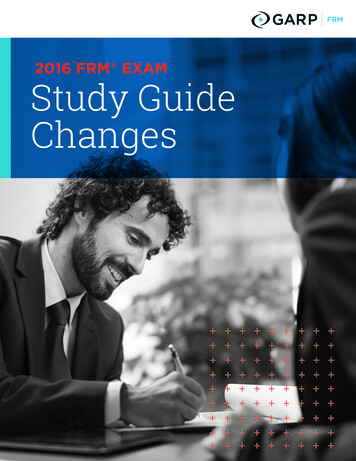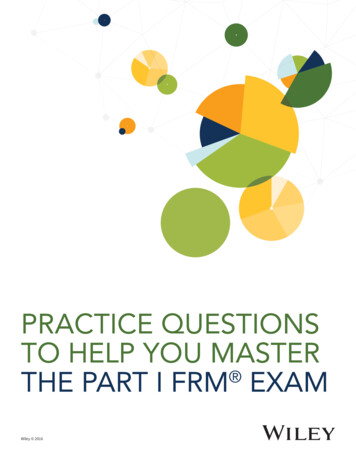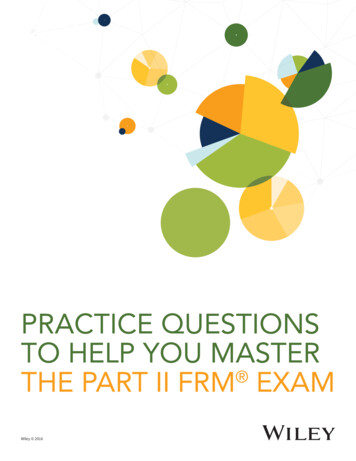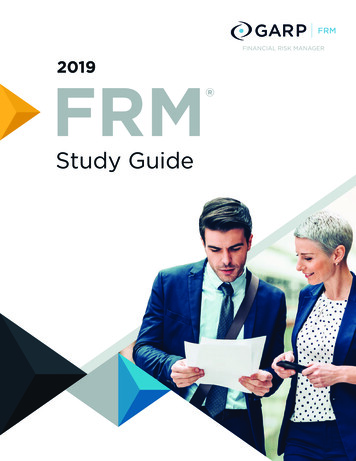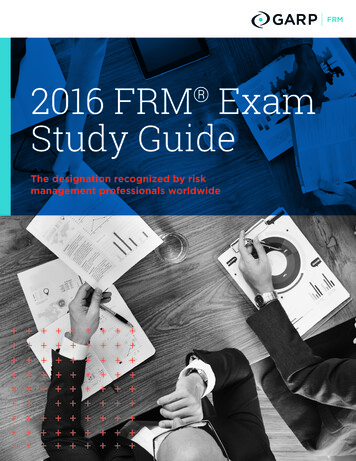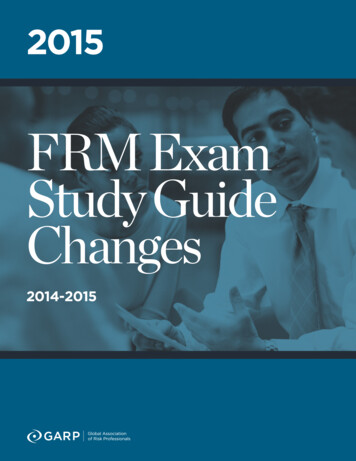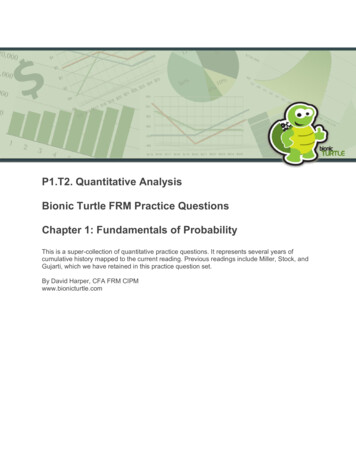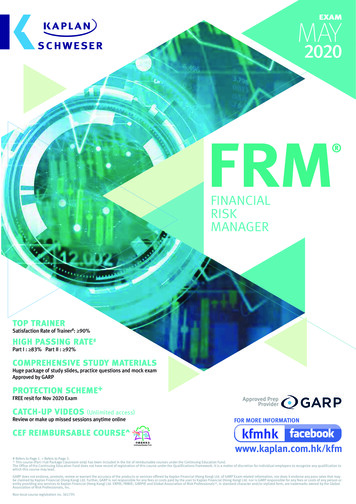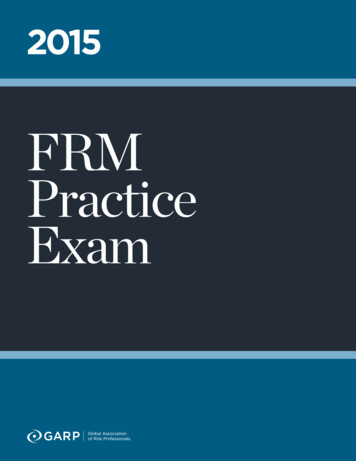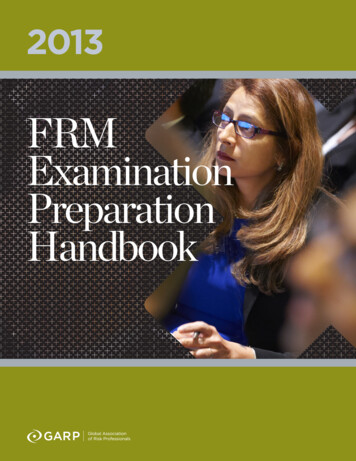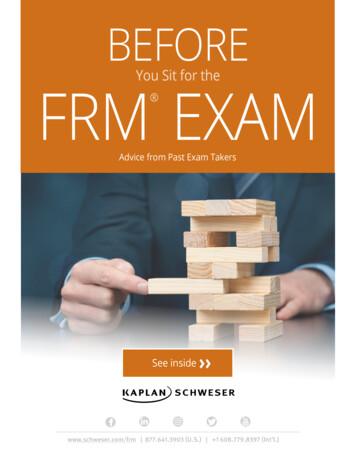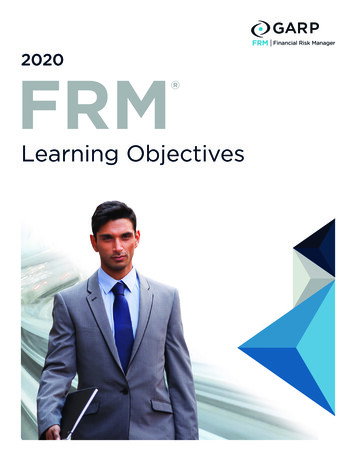
Transcription
2020FRM Learning Objectives2020 FRM Learning Objectivesgarp.org/frm1
The Global Association of Risk Professionals(GARP ) created the Financial Risk Manager(FRM ) Learning Objectives document to providea comprehensive resource for those interested inbecoming Certified FRMs.FRM LEARNING OBJECTIVESThe FRM is a comprehensive exam and you are expected to be familiar with a broad range of riskmanagement concepts and techniques. Key concepts appear in the Study Guide as bullet points at thebeginning of each section to help you identify the major themes and knowledge domains associated withthe readings listed under each section. The Learning Objectives document builds upon the Study Guideand highlights more details around the recommended readings as well as specific learning objectivesassociated with each section of the knowledge domains covered by the Exam. Approximate weightings foreach knowledge domain are assigned to help you navigate through the self-study process as these learningobjectives form the backbone of the Exam itself; therefore, it is strongly suggested that you become familiarwith these learning objectives as you review the readings.2020 FRM Learning Objectivesgarp.org/frm1
FRMLEARNINGOBJECTIVESPART I2020 FRM Learning Objectivesgarp.org/frm2
Foundations of Risk ManagementPART I EXAM WEIGHT 20% (FRM)This area focuses on foundational concepts of risk management and how risk management can addvalue to an organization. The broad knowledge points covered in Foundations of Risk Managementinclude the following: Basic risk types, measurement and management toolsCreating value with risk managementRisk governance and corporate governanceCredit risk transfer mechanismsThe Capital Asset Pricing Model (CAPM)Risk-adjusted performance measurementMultifactor modelsData aggregation and risk reportingFinancial disasters and risk management failuresEthics and the GARP Code of ConductThe readings that you should focus on for this section and the specific learning objectives that should be achieved witheach reading are as follows.Global Association of Risk Professionals. Foundations of Risk Management. New York, NY: Pearson, 2019.Chapter 1. The Building Blocks of Risk Management [FRM–1]After completing this reading you should be able to: Explain the concept of risk and compare risk management with risk taking. Describe elements, or building blocks, of the risk management process and identify problems andchallenges that can arise in the risk management process. Evaluate and apply tools and procedures used to measure and manage risk, including quantitativemeasures, qualitative assessment and enterprise risk management. Distinguish between expected loss and unexpected loss and provide examples of each. Interpret the relationship between risk and reward and explain how conflicts of interest can impactrisk management. Describe and differentiate between the key classes of risks, explain how each type of risk can arise,and assess the potential impact of each type of risk on an organization. Explain how risk factors can interact with each other and describe challenges in aggregatingrisk exposures.2020 FRM Learning Objectives Part Igarp.org/frm3
Chapter 2. How Do Firms Manage Financial Risk? [FRM–2]After completing this reading you should be able to: Compare different strategies a firm can use to manage its risk exposures and explain situations in which afirm would want to use each strategy. Explain the relationship between risk appetite and a firm’s risk management decisions. Evaluate some advantages and disadvantages of hedging risk exposures and explain challenges that canarise when implementing a hedging strategy. Apply appropriate methods to hedge operational and financial risks, including pricing, foreign currencyand interest rate risk. Assess the impact of risk management tools and instruments, including risk limits and derivatives.Chapter 3. The Governance of Risk Management [FRM–3]After completing this reading you should be able to: Explain changes in corporate risk governance that occurred as a result of the 2007-2009financial crisis. Compare and contrast best practices in corporate governance with those of risk management. Assess the role and responsibilities of the board of directors in risk governance. Evaluate the relationship between a firm’s risk appetite and its business strategy, including the role Illustrate the interdependence of functional units within a firm as it relates to risk management. Assess the role and responsibilities of a firm’s audit committee.of incentives.Chapter 4. Credit Risk Transfer Mechanisms [FRM–4]After completing this reading you should be able to: Compare different types of credit derivatives, explain how each one transfers credit risk and describetheir advantages and disadvantages. Explain different traditional approaches or mechanisms that firms can use to help mitigate credit risk. Evaluate the role of credit derivatives in the 2007-2009 financial crisis and explain changes in the creditderivative market that occurred as a result of the crisis. Explain the process of securitization, describe a special purpose vehicle (SPV) and assess the risk ofdifferent business models that banks can use for securitized products.Chapter 5. Modern Portfolio Theory (MPT) and the Capital Asset Pricing Model (CAPM) [FRM–5]After completing this reading you should be able to: Explain Modern Portfolio Theory and interpret the Markowitz efficient frontier. Understand the derivation and components of the CAPM. Describe the assumptions underlying the CAPM. Interpret the capital market line. Apply the CAPM in calculating the expected return on an asset. Interpret beta and calculate the beta of a single asset or portfolio. Calculate, compare and interpret the following performance measures: the Sharpe performance index,the Treynor performance index, the Jensen performance index, the tracking error, information ratio andSortino ratio.2020 FRM Learning Objectives Part Igarp.org/frm4
Chapter 6. The Arbitrage Pricing Theory and Multifactor Models of Risk and Return [FRM–6]After completing this reading you should be able to: Explain the Arbitrage Pricing Theory (APT), describe its assumptions and compare the APT to the CAPM. Describe the inputs (including factor betas) to a multifactor model. Calculate the expected return of an asset using a single-factor and a multifactor model. Explain models that account for correlations between asset returns in a multi-asset portfolio. Explain how to construct a portfolio to hedge exposure to multiple factors. Describe and apply the Fama-French three-factor model in estimating asset returns.Chapter 7. Principles for Effective Data Aggregation and Risk Reporting [FRM–7]After completing this reading you should be able to: Explain the potential benefits of having effective risk data aggregation and reporting. Describe the impact of data quality on model risk and the model development process. Describe key governance principles related to risk data aggregation and risk reporting practices. Identify the governance framework, risk data architecture and IT infrastructure features that cancontribute to effective risk data aggregation and risk reporting practices. Describe characteristics of a strong risk data aggregation capability and demonstrate how thesecharacteristics interact with one another. Describe characteristics of effective risk reporting practices. Describe the role that supervisors play in the monitoring and implementation of the risk data aggregationand reporting practices.Chapter 8. Enterprise Risk Management and Future Trends [FRM–8]After completing this reading you should be able to: Describe Enterprise Risk Management (ERM) and compare an ERM program with a traditional silo-basedrisk management program. Compare the benefits and costs of ERM and describe the motivations for a firm to adopt an ERM initiative. Explain best practices for the governance and implementation of an ERM program. Describe important dimensions of an ERM program and relate ERM to strategic planning. Describe risk culture, explain characteristics of a strong corporate risk culture and describe challenges to Explain the role of scenario analysis in the implementation of an ERM program and describe its Explain the use of scenario analysis in stress testing programs and in capital planning.the establishment of a strong risk culture at a firm.advantages and disadvantages.2020 FRM Learning Objectives Part Igarp.org/frm5
Chapter 9. Learning From Financial Disasters [FRM–9]After completing this reading you should be able to: Analyze the key factors that led to and derive the lessons learned from case studies involving thefollowing risk factors:-Interest rate risk, including the 1980s savings and loan crisis in the US-Funding liquidity risk, including Lehman Brothers, Continental Illinois and Northern Rock-Implementing hedging strategies, including the Metallgesellschaft case-Model risk, including the Niederhoffer case, Long Term Capital Management and the LondonWhale case-Rogue trading and misleading reporting, including the Barings case-Financial engineering and complex derivatives, including Bankers Trust, the Orange County case,and Sachsen Landesbank-Reputational risk, including the Volkswagen case-Corporate governance, including the Enron case-Cyber risk, including the SWIFT caseChapter 10. Anatomy of the Great Financial Crisis of 2007-2009 [FRM–10]After completing this reading you should be able to: Describe the historical background and provide an overview of the 2007-2009 financial crisis. Describe the build-up to the financial crisis and the factors that played an important role. Explain the role of subprime mortgages and collateralized debt obligations (CDOs) in the crisis. Compare the roles of different types of institutions in the financial crisis, including banks, financialintermediaries, mortgage brokers and lenders, and rating agencies. Describe trends in the short-term wholesale funding markets that contributed to the financial crisis, Describe responses taken by central banks in response to the crisis.including their impact on systemic risk.Chapter 11. GARP Code of Conduct.* [FRM–11]After completing this reading you should be able to: Describe the responsibility of each GARP Member with respect to professional integrity, ethical conduct,conflicts of interest, confidentiality of information and adherence to generally accepted practices inrisk management. Describe the potential consequences of violating the GARP Code of Conduct.*This reading is freely available on the GARP website.2020 FRM Learning Objectives Part Igarp.org/frm6
Quantitative AnalysisPART I EXAM WEIGHT 20% (QA)This area tests a candidate’s knowledge of basic probability and statistics, regression and time series analysisand various quantitative techniques useful in risk management. The broad knowledge points covered inQuantitative Analysis include the following: Discrete and continuous probability distributionsEstimating the parameters of distributionsPopulation and sample statisticsBayesian analysisStatistical inference and hypothesis testingMeasures of correlationLinear regression with single and multiple regressorsTime series analysis and forecastingSimulation methodsThe readings that you should focus on for this section and the specific learning objectives that should be achieved witheach reading are:Global Association of Risk Professionals. Quantitative Analysis. New York, NY: Pearson, 2019.Chapter 1: Fundamentals of Probability [QA-1]After completing this reading you should be able to: Describe an event and an event space. Describe independent events and mutually exclusive events. Explain the difference between independent events and conditionally independent events. Calculate the probability of an event for a discrete probability function. Define and calculate a conditional probability. Distinguish between conditional and unconditional probabilities. Explain and apply Bayes’ rule.Chapter 2: Random Variables [QA-2]After completing this reading you should be able to: Describe and distinguish a probability mass function from a cumulative distribution function and explainthe relationship between these two. Understand and apply the concept of a mathematical expectation of a random variable. Describe the four common population moments. Explain the differences between a probability mass function and a probability density function. Characterize the quantile function and quantile-based estimators. Explain the effect of a linear transformation of a random variable on the mean, variance, standarddeviation, skewness, kurtosis, median and interquartile range.2020 FRM Learning Objectives Part Igarp.org/frm7
Chapter 3: Common Univariate Random Variables [QA-3]After completing this reading you should be able to: Distinguish the key properties and identify the common occurrences of the following distributions:uniform distribution, Bernoulli distribution, binomial distribution, Poisson distribution, normal distribution,lognormal distribution, Chi-squared distribution, Student’s t and F-distributions. Describe a mixture distribution and explain the creation and characteristics of mixture distributions.Chapter 4: Multivariate Random Variables [QA-4]After completing this reading you should be able to: Explain how a probability matrix can be used to express a probability mass function. Compute the marginal and conditional distributions of a discrete bivariate random variable. Explain how the expectation of a function is computed for a bivariate discrete random variable. Define covariance and explain what it measures. Explain the relationship between the covariance and correlation of two random variables and how theseare related to the independence of the two variables. Explain the effects of applying linear transformations on the covariance and correlation between two Compute the variance of a weighte
2020 FRM Learning Objectives Part I garp.org/frm 7 Quantitative Analysis PART I EXAM WEIGHT 20% (QA) This area tests a candidate’s knowledge of basic probability and statistics, regression and time series analysis and various quantitative techniques useful in risk management. The broad knowledge points covered in
